A little over a year ago, four volunteer participants entered a bunker at the Johnson Space Center in Texas that was supposed to represent the planet Mars.
The goal was to help NASA understand what would be required for humans to survive on Mars in the future.
None of the volunteers — scientist Kelly Haston, structural engineer Ross Brockwell, emergency physician Nathan Jones, and microbiologist Anca Cellario — were trained as astronauts.
On Saturday evening, they were greeted with cheers and applause when they were released again after 378 days of isolation, reports said. Sky News.
“I am very proud to be helping to enable people to live on Mars in the future,” says Kelly Huston, who led the project, at a press conference.
“I am so grateful that it has allowed me to live with the idea that we cannot use resources faster than they can be replenished,” says Ross Brockwell.
Realistic Mars Conditions
In the advanced project, the crew lived under realistic Martian conditions and had to deal with the challenges that humans would face during a real visit to the Red Planet, such as isolation, scarce resources, and sparse communication with Earth.
In a 3D-printed environment measuring about 160 square meters, participants spacewalked, grew crops and handled equipment.
Meanwhile, how the mission affected the crew's cognitive and physical health was investigated.
Two similar projects are scheduled to be implemented in 2025 and 2027.

“Falls down a lot. Internet fanatic. Proud analyst. Creator. Wannabe music lover. Introvert. Tv aficionado.”






More Stories
Meteorologist on Storm Boris: ‘We expect more flooding’
More than 100 Republicans rule: Trump is unfit | World
Ignore the warning – over 100 people died